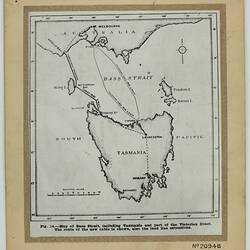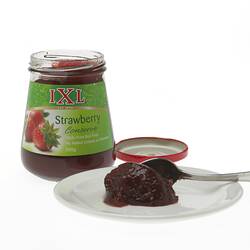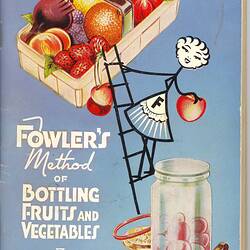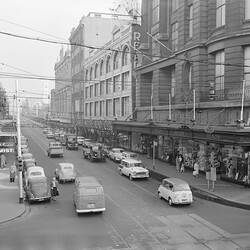Museum Victoria's jam labels were collected from the Australian Jam Company (A.J.C.) factory in Chapel Street, South Yarra in the 1970s, during the construction which would transform the site from a factory that had produced jam for more than seventy years to a shopping and entertainment complex.
Some labels in the collection show the brand of the famous Australian brand, IXL, while others show an earlier brand, Peacock's OK Jam Co. Lesser known brand names also appear in the collection, such as 'Westminster Trading Company', 'Buyer's Co.' and 'Geelong and Western Districts Preserving Co.'. The fact that little information remains about these brands or companies may be due to the fact that they were in fact owned by Henry Jones IXL, which acted during much of the twentieth century as a holding company, owning many food processing brands, especially within jam production, as well as a range of companies loosely involved with their main interest, including tin mining and freight companies (Fomin and Spierings, 1984, p. 54).
Henry Jones IXL changed names a number of times from its conception in Tasmania in the 1890s. It variously existed as Henry Jones and Co., Henry Jones Co-Operative, and Henry Jones IXL, with name changes precipitated by events such as listing as a public company. However, despite these changes, the company remained largely under the control of its original owning partners, Henry Jones, Achalen Palfreyman and Ernest Peacock. Even into the 1960s, the same surnames appear amongst the company executives, suggesting on-going family involvement (U.M.A. Accesion number 29/123).
A number of points of interest are associated with this collection and with the social and economic relations experienced within the A.J.C. factory and within the local area. During the first half of the twentieth century, Prahran was largely a poor, working class, blue-collar area. It had a largely Protestant population, with only around 1/4 of the population being Catholic (Wilde, 1993, p 124). According to Sally Wilde, 'until the 1970s about one in three of the working population of Prahran was employed in the manufacturing industry' (Wilde, 1993, p 145). Of the factories in the area, the A.J.C. was notable for its size, most factories operating in the pre-World War II years at a smaller scale (Wilde, p. 146). Figures differ as to the number of employees working at the factory, and work was often seasonal. However, during Summer and Autumn, a figure of around 1000 employees is agreed upon by both Wilde and the site planning documents (Wilde, 1993, p. 155; Interplan, 1975) . However, by the early 1970s, the area's demography had changed significantly, and the area had become a popular inner-city location. Between 1966 and 1971, the percentage of the area's population employed in white collar jobs had increased while the same figure for blue collar workers had dropped (Interplan, 1975, pp. 82-83, p. 85 . So too, a greater percentage of those working in blue collar jobs within Prahran lived outside the area, in suburbs such as Box Hill, Springvale and Oakleigh (Interplan, 1975, p. 86).
Henry Jones and Co. was taken over in 1972 by the company Food Canning Industries Pty. Ltd., and production stopped in the factory at around Easter 1973 (Fomin and Spierings, 1984, p. 56). The company announced plans for redevelopment of the site into a shopping and entertainment complex, and published an 'environmental, economic and social impact study' in October 1975 (Interplan, 1975). This study highlights the changed demography of the area, but also, interestingly, presents the new complex as a means of furthering the gentrification of the area. The complex would provide to the wealthier new residents amenities not expected by the area's previously less affluent population (Interplan, 1975, pp. 92-96). The report, written two years after the closure of the factory, highlights the creation of 381 jobs, but, due to this time of publication, does not explain where the factory jobs have been moved to or whether jobs have been lost (Interplan, 1975). Thus, one unresolved question which arises from the collection is where these blue collar jobs moved to, and whether some of the factory's employees faced unemployment partly as a result of the factory closure, and, indirectly, as a result of the gentrification of this inner Melbourne suburb.
A second point of interest, which has been largely unresolved through preliminary research, is whether the A.J.C. factory presented a safe place of work for its employees and what were its standards of work place conditions. Two secondary sources suggest that major problems existed in regards to work place conditions within the factory.
References
University of Melbourne Archives, Accession Number 29/123, Food Preservers' Union, Federal Council and Victorian Branch
Feodora Fomin and John Spierings, "The Recovery and Transformation of the Jam Factory", in 'Melbourne Historical Journal' - "The Politics of History", Vol. 16, 1984 pp 48-59.
Sally Wilde, 'Chapter 5- Working in Prahran' in The History of Prahran- Volume II: 1925-1990, (Melbourne University Press, 1993)
Interplan, Jam Factory Proposed Development, Prahran, Victoria: environmental, economic and social impact study, October 1975, prepared for Henry Jones Jam Factory by Interplan Pty. Ltd.
More Information
-
Keywords
-
Localities
-
Authors
-
Article types




